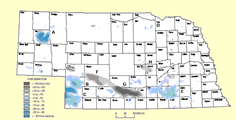Natural Resources, School of

Conservation and Survey Division: Faculty and Staff Publications
Document Type
Article
Date of this Version
2016
Citation
Published in The Holocene 2016, 14 pp. doi 10.1177/0959683616670474
Abstract
When the Laurentide ice sheet retreated rapidly (~150 m/a) across the Penobscot Lowland between ~16 and ~15 ka, the area was isostatically depressed and became inundated by the sea. Silt and clay were deposited, but no significant moraines or deltas were formed. The Penobscot River was reborn at ~14 ka when ice retreated onto land in the upper reaches of the river’s East Branch. As isostatic rebound exceeded sea level rise from melting ice, the river extended itself southward. Between ~13.4 and 12.8 ka, it established a course across marine clay and underlying glacial till in the Lowland. Its gradient was low as differential rebound had not begun. Discharge, however, was higher and the river transported and deposited outwash gravel. During the cold, dry Younger Dryas, ~11 ka, eolian sand began to accumulate in dunes in the Lowland. Some of this sand, along with fluvial sediment from the headwaters, was redistributed into terraces along gentler stretches of the river and into a paleodelta in Penobscot Bay. Eolian activity continued to ~8 ka and aggradation in terraces until ~6 ka. The climate became wetter and warmer after ~6 ka, the dunes were stabilized by vegetation, the river began to downcut, and braiding became less intense. Pauses in the downcutting are reflected in discontinuous strath terraces. In due course, the river reencountered the old outwash gravels, marine clay, glacial till, and, in a few places, bedrock. Its profile is now stepped, with gentle, gravel-bedded reaches between bedrock ribs that form rapids.
Included in
Geology Commons, Geomorphology Commons, Hydrology Commons, Paleontology Commons, Sedimentology Commons, Soil Science Commons, Stratigraphy Commons


Comments
Copyright © 2016 Roger LeB. Hooke, Paul R. Hanson, Daniel F. Belknap, and Alice R. Kelley. Published by SAGE Publications. Used by permission.